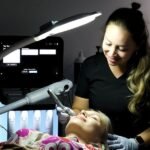The desire for breast augmentation is common among many women, and thanks to advancements in cosmetic surgery and the expertise of professionals like Dr. Luis Macias, achieving this goal can now be scar-free. Dr. Macias is a pioneer in the field of transaxillary breast augmentation, a technique that offers a discreet approach to breast enhancement without leaving visible scars on the breasts.
Transaxillary Breast Augmentation: A Scar-Free Approach
Unlike traditional methods that involve incisions on the breast, transaxillary breast augmentation utilizes the armpit region (axilla) as the entry point for implant insertion. This technique ensures that there are no visible scars on the breasts after surgery. Here’s an overview of the procedure:
Incision: A precise incision is made within the natural folds of the armpit.
Tunnel Creation: Using specialized instruments, a tunnel is created from the axilla to the breast area.
Pocket Formation: A pocket is carefully formed within the breast tissue to house the implant.
Closure: The incision site in the axilla is meticulously closed, leaving no visible scars on the breasts.
Choosing the Right Surgeon
When considering breast augmentation, choosing a board-certified professional like Dr. Macias is crucial. Board certification ensures the surgeon’s qualifications and reduces the risk of complications. Here are some factors to consider when choosing a surgeon:
Credentials and Certification: Look for a surgeon certified by the American Board of Plastic Surgery (ABPS).
Facility Accreditation: Ensure the surgeon operates in a licensed, accredited facility.
Expertise: Verify the surgeon’s experience and expertise in breast augmentation.
Client Outcomes: Review before-and-after pictures and testimonials from previous patients.
Safety Standards: Ensure the surgeon follows necessary safety protocols and uses properly maintained equipment.
Why Choose Dr. Luis Macias?
Dr. Macias is a double board-certified plastic surgeon known for achieving natural-looking results. His commitment to patient care and excellence is evident in his academic background and training:
Academic Journey: Dr. Macias began his journey at UCLA and further honed his skills at the Mayo Clinic and the University of Pennsylvania.
Expertise: He specializes in surgical and non-surgical approaches to beauty enhancement.
Innovation: Dr. Macias constantly adopts cutting-edge methods and tools to ensure the best outcomes for his patients.
Patient Experience: His clinic in Marina del Rey, California, reflects his commitment to excellence in patient care.
Frequently Asked Questions
Is This Surgery for Me? Your surgeon will determine the best procedure for you based on your medical history and goals.
What Are the Options? The most common options are fat grafting or implants, or a combination of both.
How Long Does It Last? Implants can last 15-20 years or more, depending on the type and maintenance.
What Are the Complications? The most common complication is capsular contracture, which involves the hardening of the capsule around the implant.
In conclusion, transaxillary breast augmentation offers a scar-free approach to breast enhancement, thanks to pioneers like Dr. Luis Macias. Choosing a qualified surgeon is crucial for a successful outcome, and Dr. Macias’s expertise and commitment to excellence make him an excellent choice for breast augmentation procedures.
Interested in Pioneering Excellence in Transaxillary Breast Augmentation?
Interested in learning about innovative approaches to breast augmentation? Explore “Meet Dr. Luis Macias: Pioneering Excellence in Transaxillary Breast Augmentation” and how it’s shaping the field of cosmetic surgery.
Published by: Holy Minoza










